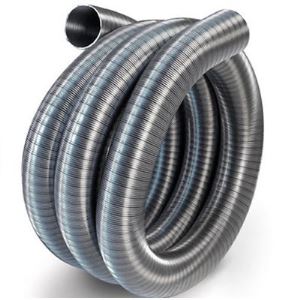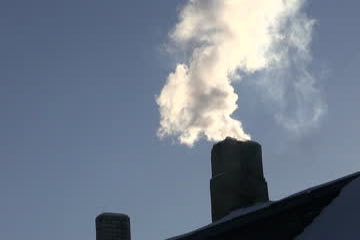There are many different issues to consider when installing a wood-burning/multifuel stove. For many people the decision whether to install a chimney/flue liner will be relatively straightforward. However, before you venture down the route of installing a wood-burning/multifuel stove, what is a flue liner and what does it do?
What is a flue liner?
Commonly referred to as a flexible flue liner, this is a stainless steel flexible tube which fits inside your chimney. In simple terms it creates a funnel by which the hot gases from your wood-burning/multifuel stove can pass easily into the atmosphere. The best description we have seen is:-
If the chimney is a polo mint then the flue is the hole
If you find a picture of a flue liner, or indeed see one in real life, it may not appear very special but it does have a special role to play.
Which homes require a flue liner?
There is no one rule that fits all but generally homes built before 1968 were constructed with brick or stone chimneys. The draw on these chimneys was not the best in the world because of the lack of additional insulation. Whereas, homes built after 1968 saw their chimney’s lined with pot, pumice or a similar product to give additional insulation. This means that the draw from the chimney stack was much better as the draft from the top of the chimney was uninterrupted by historically poor insulation on the chimney structure.
It is worth bearing in mind that even insulated chimneys will over time see a degree of deterioration thereby there is no scenario where a flexible flue liner will not improve the situation.
Heat efficiency
We have seen many people questioning the need for a flexible flue liner often comparing an open fire to a wood-burning stove. At this point it is worth reminding ourselves that modern day wood-burning stoves are 80% efficient which means that only 20% of the heat is lost up the chimney. Compare this with an open fire which is only 15% to 20% efficient with between 80% and 85% of heat lost up the chimney. So, as there are less gases escaping with a wood-burning stove there is a need for a greater draw to push the gases up and out of the chimney.
As a side note, you will often see reports regarding emissions from open fires and wood-burning/multifuel stoves where the statistics are grouped together. As we have highlighted above, comparing the efficiency of a wood-burning stove to that of an open fire is like comparing apples and pears. Utterly pointless!
Building regulations
Sceptics will point to modern day building regulations which do not generally insist on a chimney liner when installing a wood-burning/multifuel stove. However, as we have touched on above, due to the significant reduction in waste heat it is safe to say that a modern day wood-burning/multifuel stove requires as much help as possible to disperse these fumes. It is also more likely that your stove will perform to its maximum efficiency if a flexible flue liner is installed.

What might happen without a flexible flue liner?
There are many issues to take into consideration with regards to the use of flexible flue liners. The vast majority of these take into account the efficiency of the stove but also the need to maximise safety for those in the local vicinity.
Gas seepage
If a chimney is not well insulated then as the gases escape from your stove, smoke and carbon monoxide, there is every chance they could seep through the walls into your neighbour’s property. They may also find their way back into your own home and we are all aware of the potential health issues regarding these gases.
Chimney blockages
The key towards an efficient dispersal of gases from your stove is to ensure that the exit route remains hot at all times. The greater the heat the greater the draw, as the hot air is drawn upwards out into the atmosphere. If for example the chimney was not lined and cold air was to seep into the chimney structure this would very quickly cool the escaping gases which would slow their descent, leaving them stuck in the chimney or worse, sink downward back into your room.
Smooth passage
As well as the leakage of potential gases into neighbouring properties due to cold air hitting your chimney it is also advisable to have a smooth exit route. The inside of the flexible flue liner is extremely smooth thereby offering limited crevices on which the gas can attach itself and thereby slow its ascent up the chimney. If you think of this as a water shoot in your local swimming pool; the smoother the sides of the shoot, the faster your descent into the pool.
Tar like deposits and moisture
If the gas escaping from your stove is exposed to cool air in your chimney, this can create a potentially dangerous tar like deposit as well as moisture. The tar like deposit can cause significant blockages in your chimney leading to potentially serious issues further down the line. The moisture can work away at the original brickwork causing structural damage to your property and potentially neighbouring homes. When cleaning your chimney, if you find tar like deposits and excessive moisture this is a clear sign that there are greater underlying problems. In a worst-case scenario this could eventually lead to chimney fires.
Restricting stove burn
Again, using the analogy of a swimming pool shoot, if there is a blockage halfway down the tube then eventually this will cause a backlog and bring the whole system to a halt. So, if there is a blockage in your chimney, whether created by hovering gas or an actual blockage, this will eventually back up to your wood-burning stove. The consequences can be extremely dangerous aside from the fact it will impact the burn rate of your stove and the heat created.
In some cases you may experience smoke emitting from the air vents and when you open the stove door itself. It is not difficult see the potential dangers with this type of scenario.
Conclusion
The dismissal of flexible flue liners can often be used as a means of reducing the overall cost of installing a wood-burning/multifuel stove. In many ways this is very shortsighted and has potential dangers as we have highlighted above. At best, a decision not to use a flexible flue liner will impact the long-term efficiency of your stove and lead to increased fuel costs. At worst, the potential for blockages in your chimney and the backup of potentially dangerous gases being pushed back into your property can be life-threatening. Take advice, use this advice wisely and think twice before looking to reduce installation expenses at the potential cost of safety.

